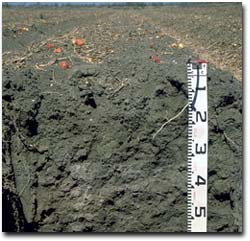Soils of the Goulburn Broken Region
This region has the following Soil Orders that you can link to. These soil orders have been classified using the Australian Soil Classification.
Sodosols | Hydrosols | Ferrosols | Vertosols | Dermosols | Kurosols | Tenosols | Rudosols | Chromosols | Kandosols
Broadscale overview soil maps are presented for each soil order and should only be used as a general indication of their distribution.
There are five main Soil Categories in the Goulburn Broken Region and these are listed below. Each of these Soil Categories contain one or more Soil Orders.
- Texture Contrast Soils
- Soils Lacking Strong Texture Contrast
- Cracking Clay Soils
- Shallow Soils
- Wet Soils
Texture contrast soils are those that display strong texture contrast between the surface (A horizons) and the subsoil (B horizons) e.g. sand or loam over clay.
In the Goulburn Broken Region, there is a range of soils with strong texture contrast, previously referred to as Duplex soils using the Northcote Factual Key.
Using the Australian Soil Classification there are three Soil Orders represented, based on subsoil chemistry (specifically pH):
- Kurosols
- Chromosols
- Sodosols
Chromosols have clay subsoils which are not strongly acid (i.e. pH >5.5 in water) and are non-sodic. Their surface texture ranges from loam to fine sandy loam over a clay subsoil. They are common throughout the region.
Sodosols have subsoils which are not strongly acid (i.e. pH >5.5 in water) but are sodic. Their surface texture ranges from sandy loam to clay loam over medium to heavy clay. Sodosols are widespread throughout the lower rainfall areas of the region and are commonly found throughout the Riverine Plains and in the low hills and rises to the east of Heathcote.
Soils Lacking Strong Texture Contrast
There are a number of soils in the Goulburn Broken region which lack strong texture contrast between the surface and subsoil horizons. These soils have previously been referred to as Gradational soils using the Northcote Factual Key. Using the Australian Soil Classification they are classified as:
- Dermosols
- Kandosols
- Ferrosols
Kandosols differ from Dermosols in that they have minimal structural development in the subsoil. They are mostly well drained and are often referred to as 'earthy' soils. They generally occur to the east and south of Seymour and often in association with Kurosols and Chromosols.
Ferrosols are deep, well-structured and friable soils that have formed on basalt. They are high in free iron oxide and clay, and are generally strongly acid.
Cracking Clay Soils

A Grey Vertosol near Corop used for tomato cropping.
These soils are referred to as Vertosols using the Australian Soil Classification. These are clay soils that shrink and swell and crack as the soil dries. They are most common in the northern plains area in the north of the region.
Shallow Soils
There are two shallow soils in the Goulburn Broken Region as classified by the Australian Soil Classification:
- Rudosols
- Tenosols
Tenosols are shallow, weakly developed soils that show more profile development than Rudosols. They generally have low water holding capacity and fertility. In the Goulburn-Broken region they are most commonly found in the south, associated with sedimentary and granite hills.
Wet Soils
These soils are referred to as Hydrosols and are saturated for many months of the year. They occur in only small areas on the Riverine Plains, particularly in the Lake Cooper and Lake Mokoan areas and other smaller swamps.

